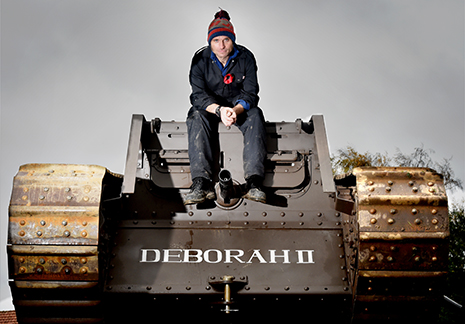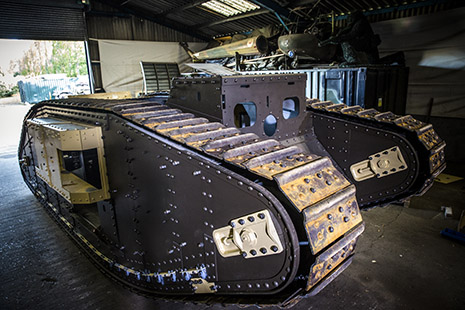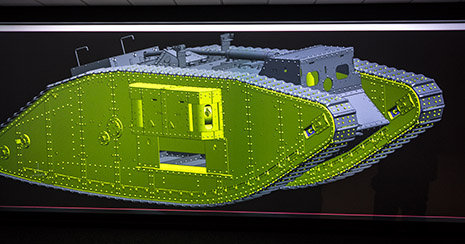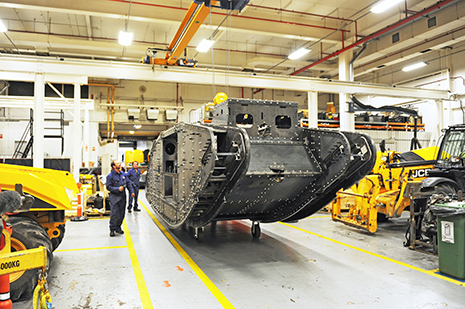
The modern-day recreation Mark IV tank will be the subject of a Channel Four programme – ‘Guy Martin’s WW1 One Tank’- to broadcast on Sunday 19 November 2017
When TV personality Guy Martin set his sights on building an authentic reproduction of a First World War tank, he called upon British manufacturer JCB, which used its skills and capabilities gained from building diggers to construct this 30-tonne tank.
A century ago in the First World War, the Mark IV tank helped the allies on the Western Front make an unprecedented breakthrough at the Battle of Cambrai, Northern France.
JCB was tasked with creating the chassis of this tank from scratch in just eight weeks, which would go on to be displayed in Cambrai on Armistice Day, Saturday 11 November 2017.

At more than 26 feet long and 10 feet wide, the 105 horsepower Mark IV tank had a top speed of just four mph
Led by JCB’s chief engineer Martyn Molsom, the project started out by adapting the CAD files supplied from a model maker in Germany, who had based the data on a Mark IV that had been blown up in the Battle of Cambrai and buried for over 70 years.

Guy Martin visited JCB’s World HQ during the early stages of production and was given a virtual reality vision of how the finished tank would look thanks to the company’s state-of-the-art VR system
Unlike the hours of manual labour the original process of cutting, drilling and punching steel would have taken 100 years ago, JCB utilised its 4,000 watt laser cutter that is capable of slicing through 15mm of solid steel to complete a similar process in minutes.
Sections of the hull, including the centre cabin and two rhomboid side panels, were built separately and welded together in just 20 days.

JCB used cutting-edge manufacturing techniques to build the chassis in a far shorter time scale than it would have taken in 1917
The team were keen to ensure the Mark IV looked entirely authentic and 3,000 fake rivets – used to join the original tank together – were attached to the replica using a robot welder.
“We used modern techniques to rebuild the machine, but the biggest problem was to make it look as though it had just come off the factory line during the war,” explains design engineer Tom Beamish.
“All of the welding work was done on the back side of the steel plates, so it wouldn’t be visible externally, but the specifications are exactly how they would have been back then. We even replicated the roller spacing for the tracks of the tank, so it would sound exactly the same as the original,” adds Beamish.

During his visit to JCB, Guy Martin even helped lend a hand in the welding shop
The completed chassis was transported to Norfolk tank museum, near Norwich, where the remainder of the project took place.
Two ‘sponsons’ – projections extending from the side of the machine – along with a roof section and other parts, also manufactured at JCB, were lifted into place before a restored six-cylinder Rolls Royce engine, tractor gearbox, tractor axles and excavator tracks were fitted.

The JCB team who delivered the project were chief engineer Martyn Molsom, design engineer Tom Beamish, welder Chris Shenton, and welder Chris Brennan
The four JCB employees involved in the project were invited to witness the tank take part in a re-enactment of the moment 100 years ago that tanks first saw action in Cambrai. They also took part in poignant commemorations in Cambrai.
Martyn Molsom says: “The reproduction of a Mark IV tank from a century ago is a great British manufacturing story and that’s one of the reasons we wanted to get involved in the project. Replicating that innovation in a few weeks was a massive task, but modern techniques and equipment made it a lot easier for us than it would have been back then.
“It was a fascinating project to be involved in, both from an engineering point of view and from the historical aspect, and I was delighted we could make it happen. I don’t think any other company in the UK would have been able to pull it off in such a short time-frame, so I’m proud that it worked out so well.”
The tank, which will now return to the UK where it will remain at the Norfolk Museum, is the subject of a two-hour Channel Four programme – Guy Martin’s WW1 One Tank – that follows the entire rebuilding process and will be broadcast on Sunday 19 November 2017.






